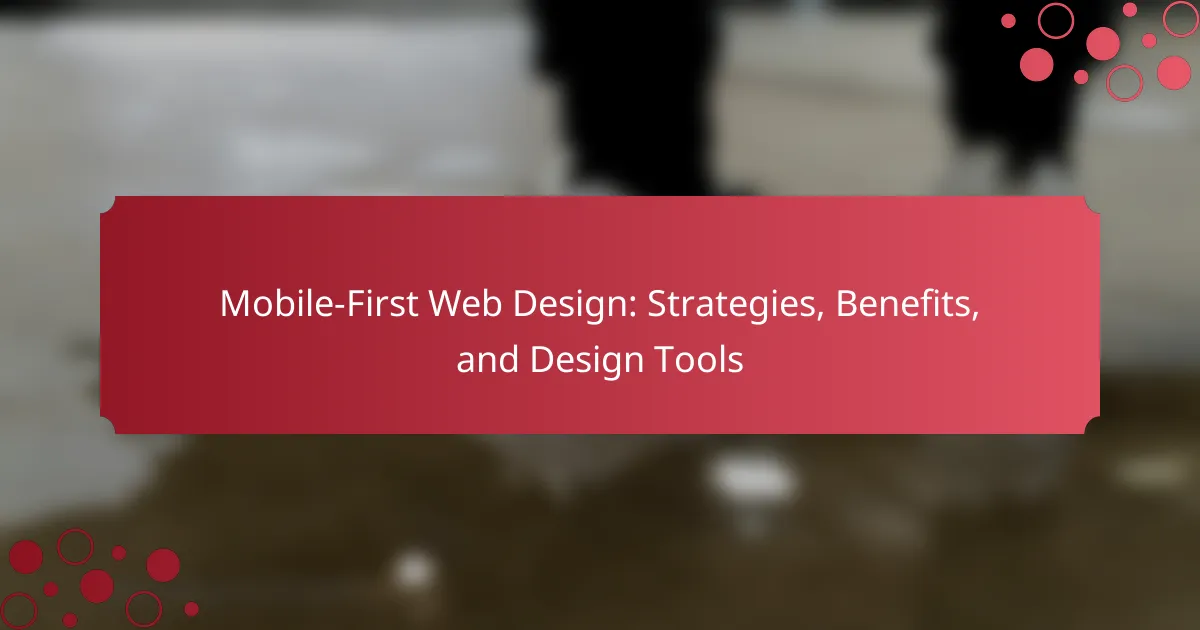Mobile-First Web Design is a strategic approach that emphasizes creating websites optimized for mobile devices before developing desktop versions. This methodology enhances user experience by ensuring fast loading times and improved usability on smaller screens, which is crucial given that over 54% of global website traffic originates from mobile devices. The article explores the benefits of Mobile-First Web Design, including increased engagement and conversion rates, as well as its impact on search engine rankings. Additionally, it highlights essential design tools such as Figma, Adobe XD, and Sketch, which facilitate the creation of responsive layouts and user interfaces. Overall, adopting a Mobile-First strategy aligns with current user behavior and is vital for effective web development.

What is Mobile-First Web Design?
Mobile-First Web Design is a design approach that prioritizes the development of websites for mobile devices before desktop versions. This strategy focuses on creating a seamless user experience on smaller screens. The design process starts with mobile layouts and features, then scales up to accommodate larger devices. This method is essential due to the increasing number of users accessing the internet via mobile devices. According to Statista, as of 2021, mobile devices accounted for over 54% of global website traffic. Prioritizing mobile design helps improve loading times and enhances usability for mobile users.
How does Mobile-First Web Design differ from traditional web design?
Mobile-First Web Design prioritizes the design process for mobile devices before desktop. Traditional web design often starts with desktop layouts, then adapts to mobile. Mobile-First focuses on essential features for smaller screens. This approach enhances user experience on mobile devices, which are increasingly predominant. According to Statista, mobile devices accounted for over 54% of global website traffic in 2021. Mobile-First designs are typically more streamlined and faster to load. This is crucial since Google prioritizes mobile-friendly sites in search rankings. In contrast, traditional designs may suffer from unnecessary elements when scaled down.
What are the key principles of Mobile-First Web Design?
Mobile-First Web Design prioritizes designing for mobile devices before desktop. This approach ensures optimal user experience on smaller screens. Key principles include responsive design, which adapts layouts to various screen sizes. Another principle is performance optimization, focusing on fast loading times for mobile users. Content prioritization is also crucial, emphasizing essential information first. Touch-friendly navigation enhances usability on mobile devices. Finally, testing on real mobile devices is vital to identify and fix issues early. These principles collectively improve mobile user engagement and satisfaction.
Why is Mobile-First Web Design important in today’s digital landscape?
Mobile-First Web Design is important because it prioritizes the user experience on mobile devices. With over 50% of global web traffic coming from mobile users, designing for mobile first ensures accessibility. This approach enhances loading speed and performance on smaller screens. It also improves search engine rankings, as Google favors mobile-friendly sites. According to Google, mobile-friendly websites are 62% more likely to generate sales. Additionally, it allows for a streamlined design process, focusing on essential content. This method caters to the increasing reliance on smartphones for internet access. Therefore, Mobile-First Web Design aligns with current user behavior and technological trends.
What are the core strategies for implementing Mobile-First Web Design?
The core strategies for implementing Mobile-First Web Design include prioritizing content, designing for touch, and optimizing performance. Prioritizing content means identifying the most essential elements for mobile users. This ensures that critical information is easily accessible. Designing for touch involves creating larger buttons and interactive elements that are user-friendly on smaller screens. Optimizing performance focuses on reducing load times through efficient coding and image compression. Research shows that mobile users expect pages to load in under three seconds. Implementing these strategies enhances user experience and engagement on mobile devices.
How can responsive design enhance Mobile-First strategies?
Responsive design enhances Mobile-First strategies by ensuring optimal user experiences across various devices. It allows websites to adapt seamlessly to different screen sizes and orientations. This adaptability improves usability for mobile users, who constitute a significant portion of web traffic. According to Statista, mobile devices accounted for over 54% of global website traffic in 2021. Responsive design also improves loading times on mobile devices, which is crucial since 53% of mobile users abandon sites that take longer than three seconds to load. Furthermore, search engines like Google prioritize mobile-friendly sites in their rankings, boosting visibility. Overall, responsive design aligns with Mobile-First strategies by creating a user-centric approach that enhances engagement and retention.
What role does user experience play in Mobile-First Web Design?
User experience is critical in Mobile-First Web Design. It focuses on optimizing the design for mobile users first. This approach ensures that the website is accessible and functional on smaller screens. Research shows that 57% of users will abandon a site if it takes more than three seconds to load. A positive user experience leads to higher engagement and conversion rates. Mobile-First design prioritizes essential content and simplifies navigation. This enhances usability and satisfaction for mobile users. Effective Mobile-First design can improve overall website performance and user retention.

What benefits does Mobile-First Web Design offer?
Mobile-First Web Design offers enhanced user experience and improved search engine rankings. This design approach prioritizes mobile devices, ensuring that websites load quickly and function effectively on smaller screens. According to Google, over 60% of searches now come from mobile devices. A mobile-first strategy leads to faster loading times, which can reduce bounce rates by up to 50%. Additionally, responsive designs improve accessibility, allowing users to navigate effortlessly across various devices. Businesses adopting mobile-first design can see increased engagement and conversion rates, as users prefer websites optimized for their devices. Ultimately, mobile-first design aligns with current user behavior and preferences, making it essential for modern web development.
How does Mobile-First Web Design impact site performance?
Mobile-First Web Design significantly enhances site performance. It prioritizes the mobile user experience, ensuring faster load times. Research indicates that mobile-optimized sites load 1.5 times faster than traditional desktop-first designs. This approach reduces unnecessary elements, streamlining code and improving efficiency. Additionally, Google’s algorithm favors mobile-friendly sites, boosting their search rankings. A study by Google found that 53% of mobile users abandon sites that take over three seconds to load. Therefore, implementing Mobile-First Web Design can lead to better user engagement and lower bounce rates.
What are the SEO advantages of adopting a Mobile-First approach?
Adopting a Mobile-First approach enhances SEO by prioritizing mobile user experience. Search engines like Google use mobile-first indexing, meaning they primarily consider the mobile version of a site for rankings. This leads to improved visibility in search results. Mobile-optimized sites load faster, reducing bounce rates. Faster load times correlate with better user engagement and higher conversion rates. Additionally, a Mobile-First design often results in cleaner, more intuitive navigation. This can enhance user satisfaction, leading to longer site visits. According to Google, 53% of mobile users abandon sites that take longer than three seconds to load. Therefore, a Mobile-First approach directly impacts SEO performance positively.
How does Mobile-First Web Design improve user engagement?
Mobile-First Web Design improves user engagement by prioritizing the mobile experience in website development. This approach ensures that websites are optimized for smaller screens and touch interactions. As a result, users experience faster load times and more intuitive navigation. Research shows that mobile users are more likely to engage with sites that load quickly and are easy to navigate. According to Google, 53% of mobile users abandon sites that take longer than three seconds to load. Additionally, mobile-first design often leads to cleaner layouts, reducing clutter and enhancing user focus. This clarity encourages users to interact more with content, increasing overall engagement metrics.
Which businesses benefit most from Mobile-First Web Design?
E-commerce businesses benefit most from Mobile-First Web Design. These businesses rely heavily on mobile traffic for sales. According to Statista, mobile e-commerce accounted for 54% of total e-commerce sales in 2021. Retailers with mobile-optimized sites see higher conversion rates. Service-based businesses also gain from Mobile-First design. They often target mobile users for quick access to information. Restaurants and booking services experience increased foot traffic from mobile users. Local businesses benefit from improved visibility in mobile search results. Overall, any business targeting a mobile audience will see advantages from this design approach.
What industries are leading the way in Mobile-First adoption?
Retail, media, and travel industries are leading the way in Mobile-First adoption. Retailers prioritize mobile platforms for shopping experiences. According to Statista, mobile e-commerce sales are projected to reach $3.56 trillion by 2021. Media companies focus on mobile content consumption. Reports indicate that mobile devices accounted for over 70% of digital media time in 2020. The travel industry leverages mobile apps for booking and customer engagement. A survey by eMarketer found that 68% of travelers use mobile devices for travel planning. These industries exemplify the shift towards Mobile-First strategies.
How can small businesses leverage Mobile-First Web Design for growth?
Small businesses can leverage Mobile-First Web Design for growth by prioritizing mobile user experience. This approach ensures that websites are optimized for mobile devices first, leading to faster load times. Research shows that 53% of mobile users abandon sites that take over three seconds to load.
By focusing on mobile design, small businesses can improve user engagement. A seamless mobile experience can increase conversion rates significantly. According to a study by Google, mobile-friendly websites can boost sales by up to 20%.
Additionally, Mobile-First design enhances search engine rankings. Google prioritizes mobile-friendly sites in its search results. This visibility can attract more potential customers.
Investing in responsive design tools is also beneficial. These tools allow for easier updates and maintenance. As a result, small businesses can adapt quickly to changing market demands.

What design tools are essential for Mobile-First Web Design?
Essential design tools for Mobile-First Web Design include Figma, Adobe XD, and Sketch. Figma allows real-time collaboration and prototyping. Adobe XD offers powerful design and sharing capabilities. Sketch is favored for its user-friendly interface and extensive plugin ecosystem. These tools support responsive design and mobile optimization. They facilitate the creation of mobile layouts and user interfaces. Using these tools enhances efficiency and creativity in mobile-first projects.
Which design tools facilitate the Mobile-First approach?
Design tools that facilitate the Mobile-First approach include Figma, Adobe XD, and Sketch. Figma allows for collaborative design and responsive layouts. Adobe XD offers tools for prototyping and testing on mobile devices. Sketch is known for its vector graphics and user interface design capabilities. These tools support designing interfaces that prioritize mobile user experience. They enable designers to create layouts that adapt seamlessly to different screen sizes. This approach is essential as mobile traffic accounts for over 50% of global web traffic.
How do prototyping tools enhance Mobile-First Web Design?
Prototyping tools enhance Mobile-First Web Design by enabling rapid iteration and user testing. These tools allow designers to create interactive mockups that simulate mobile user experiences. This process helps identify usability issues early in the design phase. Designers can gather feedback from real users quickly. According to a study by Nielsen Norman Group, early user testing can reduce design errors by up to 50%. Prototyping tools also support collaboration among team members. They allow for easy sharing and commenting on designs. This fosters a more efficient design process tailored to mobile users’ needs.
What analytics tools help measure the effectiveness of Mobile-First strategies?
Google Analytics provides comprehensive insights into mobile user behavior. It tracks metrics like page views, bounce rates, and session durations specifically for mobile devices. This data helps assess the effectiveness of Mobile-First strategies. Another valuable tool is Hotjar, which offers heatmaps and session recordings. These features reveal how users interact with mobile layouts. Additionally, Mixpanel focuses on user engagement and retention metrics. It allows businesses to analyze mobile-specific events and conversions. Adobe Analytics also supports mobile tracking and offers advanced segmentation features. These tools collectively provide a robust framework for measuring Mobile-First strategy effectiveness.
What best practices should be followed in Mobile-First Web Design?
Mobile-First Web Design emphasizes designing for mobile devices before desktops. Prioritize responsive design to ensure usability on various screen sizes. Utilize a fluid grid layout to adapt content dynamically. Optimize images and assets for faster loading times. Implement touch-friendly navigation elements for better user interaction. Limit the use of large blocks of text to enhance readability. Test designs on multiple devices to ensure compatibility. Use mobile-specific features, such as geolocation and camera access, to enhance user experience. These practices improve engagement and retention on mobile platforms.
How can designers ensure accessibility in Mobile-First Web Design?
Designers can ensure accessibility in Mobile-First Web Design by following specific guidelines. They should use responsive design techniques to adapt layouts for various screen sizes. This ensures that content is easily readable on mobile devices. Designers must implement semantic HTML to improve screen reader compatibility. Alt text for images is essential for visually impaired users. Color contrast should meet accessibility standards for better visibility. Touch targets must be large enough for users with motor impairments. Designers should test their designs with actual users, including those with disabilities, to gather feedback. Adhering to the Web Content Accessibility Guidelines (WCAG) provides a framework for creating accessible content.
What are common pitfalls to avoid in Mobile-First Web Design?
Common pitfalls to avoid in Mobile-First Web Design include neglecting performance optimization. Slow loading times can lead to high bounce rates. Another pitfall is inadequate touch target sizes. Small buttons can frustrate users and hinder navigation. Failing to prioritize content hierarchy is also critical. Important information should be easily accessible on smaller screens. Overlooking responsive design principles can create poor user experiences. Elements must adapt seamlessly across devices. Lastly, ignoring user feedback can result in missed opportunities for improvement. Continuous testing and iteration are essential for success.
What are practical tips for implementing Mobile-First Web Design?
Start with a mobile design approach. Prioritize essential content for smaller screens. Utilize responsive design techniques to ensure adaptability. Optimize images and assets for quick loading times. Test designs on various mobile devices for usability. Implement touch-friendly navigation elements. Use a fluid grid layout for flexibility. Consider mobile user behaviors during the design process.
Mobile-First Web Design is a strategic approach that prioritizes the creation of websites optimized for mobile devices before adapting them for desktop use. This article covers the importance of Mobile-First design in enhancing user experience, improving site performance, and boosting search engine rankings. It outlines the key principles and strategies for implementing this design approach, highlights essential design tools, and discusses best practices for ensuring accessibility. Additionally, the article identifies industries that benefit most from Mobile-First design and offers practical tips for small businesses to leverage this strategy for growth.
